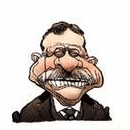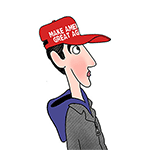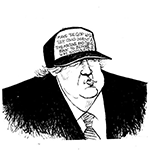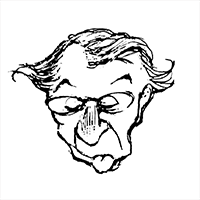Kamala Harris says Trump economic plan will cost middle class households $4,000. Is she correct?
Published in Political News
Vice President Kamala Harris says it over and over — former President Donald Trump is pushing a plan that “has been estimated to cost a typical American family $4,000 per year.”
Harris is referring to her opponent’s plan to increase tariffs, which she says in her 82-page economic plan is “in effect a national sales tax on all products used by everyday families that are imported, from groceries to clothes to gas to prescription drugs.”
Economists left, right and center generally agree.
The left-leaning Center for American Progress Action fund estimates Trump’s plans would “amount to an annual $2,500 tax increase for a family in the middle of the income distribution.” Among its predictions are a $260 tax on electronics, $160 tax on clothing, a $120 tax on oil, and $110 tax on food.
The more conservative Tax Foundation, using different methods of calculating income and using other economic assumptions, puts the increase at around $6,000.
At the nonpartisan Peterson Institute for International Economics, senior fellows Kimberly Clausing and Mary Lovely estimated that the tariffs would cost a middle income household $1,700 a year.
Trump and his supporters counter that the Biden administration has continued many of the tariffs Trump imposed during his presidency, and there’s little evidence tariffs have been a major reason prices jumped in recent years.
“Kamala Harris is trying to fearmonger, and lies about his plan – even though she and Joe Biden kept the Trump era tariffs in place,” said Anna Kelly, Republican Party spokeswoman.
The Trump campaign cited the former president’s remarks in Savannah, Georgia, last month as an argument for the tariff proposals.
“The word tariff properly used is a beautiful word…A lot of bad people didn’t like that word, but now they’re finding out I was right, and we will take in hundreds of billions of dollars into our treasury and use that money to benefit the American citizens,” Trump said.
The entire debate is centered on Trump saying the United States should impose a 10% tariff, or tax, on imports from other countries. He has suggested the tariffs could go as high as 60% on imports from China.
Analysts have said for years that companies not only tend to pass the tariff costs on to consumers, but additional costs derive from higher prices for the material and labor it can then take to produce products in this country.
Trump maintains “there was no inflation” during his presidency, despite the tariffs. The rate of inflation was 2.4% in 2018, the first full year of his presidency, and 1.8% in 2019, the last year before the COVID pandemic. The rate of inflation peaked at 9.1% in June 2022. The latest data, for the year ending in September, had the rate down to 2.4%.
Harris cites that progress, and argues that Trump’s tariffs will push the rate up again. It’s one of the more stark contrasts on economics between the two candidates.
“Harris has always opposed tariffs because she can’t be trusted to put workers first,” said the Trump campaign’s Kelly.
Harris maintains that not only would Trump’s plan be costly, but it’s not really even a plan.
“You don’t just throw around the idea of just tariffs across the board, and that’s part of the problem with Donald Trump,” Harris told MSNBC in an interview last month. “I say this in all sincerity, he’s just not very serious about how he thinks about some of these issues.”
_____
©2024 McClatchy Washington Bureau. Visit mcclatchydc.com. Distributed by Tribune Content Agency, LLC.




























































Comments